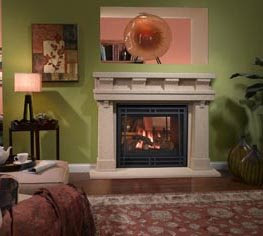Summary: Direct vent gas fireplaces are energy efficient, do not waste heat, and do not require a chimney.
Hi Carl,
I bought your book a while ago.
I’m reading it for the second time now because I’m starting the process of building a home.
Working on the budget right now.
In your book you mention energy efficient fireplaces.
Can you give a source with more information on it?
Thank you!
G.P. in Canada
Hi G.P.
Well, at first, the term energy efficient fireplace, or energy efficient fireplaces, sounds like an oxymoron.
That’s because normally, a fireplace is a hole in a wall that sucks expensively heated air out of a room.
It doesn't matter whether it’s a gas fireplace, or a wood burning fireplace, or even if the fireplace has glass fireplace doors, they all draw inside air for the process of combustion.
Even fireplaces that now have a fresh air makeup vent in the back or side of the firebox draw room air as well as out side air.
The only fireplace that I am aware of that is energy efficient is a direct vent fireplace.
A direct vent fireplace draws no inside air at all. It draws 100 per cent of its combustion air from outside.
A direct vent fireplace also exhausts the combusted gases outside as well, protecting indoor air quality and, radiated heat from the fireplace stays in the house.
These fireplaces can be installed in areas of the home that were never thought of before.
They can even be installed under a window.

See-thru fireplace. Photo courtesy of Heatilator
Another benefit of these fireplaces is that the cost of building a chimney is eliminated, thereby saving that construction headache and expense.
Many people complain about missing the smell of a real wood fire when using a gas fireplace
Well, you aren't supposed to smell wood smoke from any fireplace inside your house! The wood burning smell is actually back drafting exhaust gases…Yikes! If you miss the smell of wood burning, burn a stick of incense. Stay warm, save energy, Carl Heldmann


